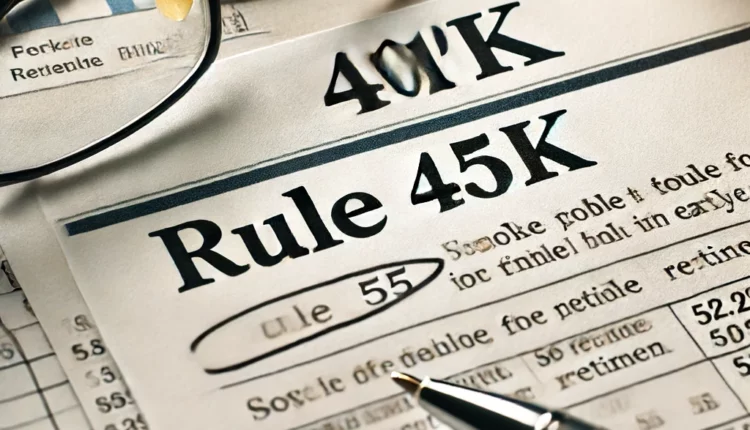Understanding Rule 55 and Your 401(k): A Pathway to Early Retirement
When we think about retirement, we often envision it as a distant horizon. However, for those looking to retire early, Rule 55 can be a golden ticket to accessing your 401(k) funds without penalties. This little-known provision offers a strategic advantage to individuals aged 55 or older who leave their jobs and want to tap into their retirement savings. But what exactly is Rule 55 400k, and how can it benefit you? Let’s dive into the details.
Contents
What is Rule 55 401(k)?
Rule 55 is a provision under the Internal Revenue Code that allows individuals who leave their job during or after the year they turn 55 to withdraw funds from their 401(k) without the usual 10% early withdrawal penalty. This can be a game-changer for those planning early retirement or simply seeking financial flexibility in their mid-50s.
Understanding the Basics of Rule 55 401(k)
To fully appreciate the benefits of Rule 55, it’s crucial to understand how it works. Usually, withdrawing from a 401(k) before reaching age 59½ incurs a 10% penalty on top of regular income taxes. However, under Rule 55, if you leave your job in or after the calendar year you turn 55, you can withdraw from your 401(k) without penalty.
For example, if you turn 55 in March and decide to retire or leave your job in April, you can start taking penalty-free withdrawals immediately. This rule applies to your current employer’s 401(k) plan and does not extend to previous employer plans or other retirement accounts like IRAs.

Eligibility for Rule 55 401(k)
Not everyone can take advantage of Rule 55. To qualify:
- You must leave your job during or after the calendar year in which you turn 55.
- The 401(k) plan from which you are withdrawing must be the plan of the employer you just left. This is crucial because funds in 401(k) plans from previous employers or in IRAs are not eligible under Rule 55.
How to Use Rule 55 401(k) to Your Advantage
Rule 55 can be a powerful tool if used wisely. Here’s how you can leverage it for your benefit:
Early Retirement Planning with Rule 55 401(k)
If you’re considering early retirement, planning is key. Rule 55 can provide a source of income to bridge the gap between early retirement and when other retirement benefits, like Social Security or IRA withdrawals, become available without penalties. By understanding and applying Rule 55, you can:
- Avoid the 10% early withdrawal penalty, which can significantly reduce the financial hit of tapping into your retirement savings early.
- Strategically withdraw only what you need, thus preserving your nest egg.
Financial Flexibility Post-Employment
Life after leaving a job at 55 can bring unexpected expenses or opportunities. Rule 55 offers the flexibility to address these needs without the immediate tax penalty burden. Whether it’s starting a new venture, covering healthcare costs, or simply enjoying some freedom, this provision allows you to use your funds more freely.
Tax Considerations
While Rule 55 helps avoid the early withdrawal penalty, it’s important to remember that withdrawals are still subject to regular income taxes. Planning your withdrawals carefully can help you manage your tax bracket and avoid unnecessary tax burdens. Consider consulting with a financial advisor to develop a tax-efficient withdrawal strategy.
Rule 55 401(k) vs. Other Early Withdrawal Options
Comparing Rule 55 with other options for early retirement withdrawals can help you make an informed decision about the best approach for your situation.
Rule 55 401(k) vs. IRA Withdrawals
Unlike 401(k) plans, IRAs do not qualify for Rule 55. To withdraw from an IRA without penalties before age 59½, you would need to meet specific criteria such as disability, higher education expenses, or first-time home purchase. Therefore, Rule 55 offers a unique advantage for 401(k) holders over IRA account holders.
Rule 55 401(k) vs. Substantially Equal Periodic Payments (SEPP)
Another option for penalty-free early withdrawals from retirement accounts is setting up Substantially Equal Periodic Payments (SEPP). However, SEPP comes with stringent rules and requires you to commit to a fixed withdrawal schedule for at least five years or until you turn 59½, whichever is longer. In contrast, Rule 55 provides more flexibility, as you can withdraw as needed without such rigid constraints.
Practical Tips for Using Rule 55 401(k)
Maximizing the benefits of Rule 55 requires careful planning. Here are some practical tips to consider:
Consult with Your Employer and Plan Administrator
Before making any withdrawals, consult with your employer and the plan administrator to ensure your 401(k) plan permits withdrawals under Rule 55. Not all plans are the same, and some may have additional stipulations.
Calculate Your Withdrawal Needs
Determine how much you need to withdraw to cover your expenses and consider the tax implications. Withdrawing only what you need can help preserve your savings and manage your tax burden effectively.
Consider Rolling Over Other Retirement Accounts
If you have funds in previous employers’ 401(k) plans or IRAs, consider rolling them into your current employer’s 401(k) plan before you leave your job. This can consolidate your funds under one plan, making them eligible for Rule 55.
Common Questions About Rule 55 401(k)
Understanding Rule 55 can be complex. Here are answers to some common questions that might help clarify its application.
Can I Use Rule 55 More Than Once?
Yes, you can use Rule 55 multiple times if you qualify. For instance, if you leave a job at 55 and later start working again, you could potentially take advantage of Rule 55 again if you leave your new job at 55 or older.
What Happens If I Leave My Job Before Turning 55?
If you leave your job before the calendar year in which you turn 55, you won’t qualify for Rule 55. In such cases, you would need to look at other options like waiting until 59½ or considering SEPP for penalty-free withdrawals.
How Does Rule 55 Affect My Retirement Strategy?
Rule 55 provides a valuable option for early retirees or those needing financial flexibility at 55. It allows for penalty-free access to funds, which can be a critical component of your broader retirement strategy. However, it’s important to balance withdrawals with long-term retirement needs and tax planning.
Final Thoughts on Rule 55 401(k)
Rule 55 offers a unique opportunity for those aged 55 and older to access their 401(k) funds without the burden of early withdrawal penalties. Whether you’re planning an early retirement or need financial flexibility, understanding and utilizing Rule 55 can significantly impact your financial well-being.
At Carmichael Hill, we’re committed to helping you navigate these complex rules and optimize your retirement strategy. By incorporating Rule 55 into your plan, you can gain greater control over your retirement funds and tailor your approach to fit your unique needs.
Ready to explore how Rule 55 can benefit your retirement plan? Contact us today for personalized advice and support in managing your retirement funds.

